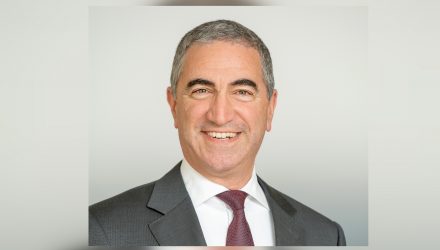Investors aren’t always thinking about commodities, but Teucrium CEO Sal Gilbertie is. Even with the Magnificent Seven leading the market, commodities can provide meaningful diversification. While commodities like gold and grain may not spark excitement at first, they can offer major benefits to a portfolio.
Commodities as a Diversifier
“Commodities are such a good diversifier,” Gilbertie said. “In these times when the stock market tends to go straight up without much of a pause, people aren’t looking at alternatives…as soon as there’s a blip, people start saying, ‘wait, what happened’?”
“That little, tiny holding inside your portfolio that might have been a multi-commodity index, it might have been out sugar fund last year, people call up and say ‘wow, there’s some green here’,” he added.
It’s easy to say that commodities are diversifiers, but just how do they do that? Even though a multi-commodities basket can produce just as much volatility as the S&P 500, Gilbertie said, adding commodities to a portfolio can still lower the overall volatility given how commodities move to their own fundamentals.
“It doesn’t matter what the latest iPhone is, who the president is, or what the S&P 500 is doing,” he said. “People are still going to eat their bagel in the morning… In essence, commodities zig when markets zag.”
Of course, when investors hear “diversifier,” that doesn’t necessarily spark excitement either – especially in the world of the Magnificent Seven. Commodities, however, can offer some serious alpha on their own, Gilbertie said.
Given that the combined use of corn, soybeans, and wheat has set a record or sat just below a record every year since 1960, he said, demand is always rising. The Golden Grain cycle, Gilbertie called it, illustrates the scenario in which low, flatlined, subsidized agricultural prices see price spikes due to market events.
The Golden Grain Cycle and Alpha in Commodities
In this cycle, Gilbert explained, investors buy during the flatline period to sell during the spikes. When grain prices rise – like corn, for example – farms respond by planting extra corn, pushing the price down.
“High prices get rid of high prices,” he said. “For more than a decade, when the price of oil goes below $40 a barrel, literally billions and billions flow into the oil ETFs. People understand that oil goes back up. People are just starting to do that with grains.”
Gilbertie summarizes the approach to take, then, as “weight, wait, drought, out.” Investors weight some part of their portfolio into commodities when the price flatlines. Then, they wait for the price to rise, due to something like a drought. Then, they get out.
“If somebody said to you, ‘There’s an asset class that starts at the same price, and it doubles every two to six years statistically, and it’s done it three times in the last 15 years. You’re going to say, ‘the next time it gets back down or whatever that is, why don’t you give me a call?’”
A commodity like corn, then, can play the role of diversifier and alpha generator. Corn diversifies away from the regular tumult of the market, and, if used via the so-called Golden Grain cycle, it can potentially offer notable returns.
“If you put 1% of your portfolio in something that is going to go down 10%, it affects your portfolio by a 10th of a percent,” Gilbertie said. “If you put 1% of your portfolio in something that’s going to go up by 100% At some point, you just gained 1% that year.”
Teucrium’s Commodity ETFs
Teucrium offers a variety of commodity-specific ETFs, like the Teucrium Corn Fund (CORN). CORN itself takes a neutral investment strategy to track its benchmark.
CORN tracks three futures contracts for corn traded on the Chicago Board of Trade. By using a variety of exposures, it looks to reduce the impact of market contango. CORN charges 271 basis points (bps) for its approach.
The firm also offers a long-short agricultural strategy with which to invest in commodities during the “wait” to sell commodities at a price spike. The Teucrium AiLA Long-Short Agriculture Strategy ETF (OAIA) charges 163 bps to provide long/short exposure to commodity futures contracts.
For more news, information, and analysis, visit the Commodities Channel.

